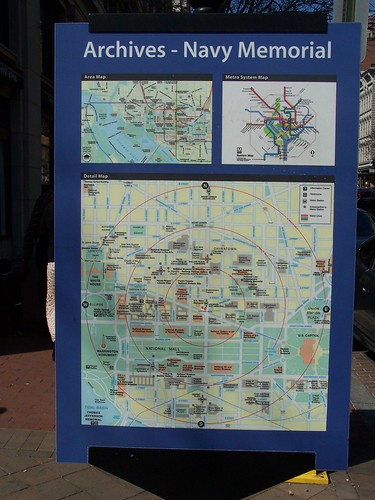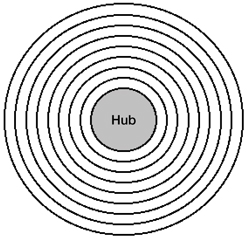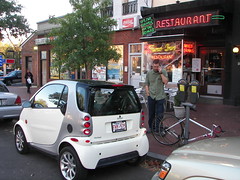Updating the mobilityshed / mobility shed concept
The idea has to do with mobility and compact development being linked, where (1) walking, bicycling, and transit is part of your daily and week-in, week-out lifestyle/way of life, rather than something you do specially such as going on a special trip for recreation (such as to a gym or a park miles away) or only to go to and from work; and (2) planning for mobility around what I call the mobilityshed and transitshed.
The transit shed is the area impacted by a transit line, the mobilityshed is the planning for mode shift within catchment areas around stations, which should include bicycle sharing stations, although they weren't listed in my first writing about it, and/or transit lines in total.

Map signs at DC subway stations usually show three concentric circles representing 1/4, 1/2, and 3/4 mile walking areas (which are supposed to reflect 5, 10, and 15 minute walking distances).
I think you can think of bicycle sharing systems as different from owning a bicycle in terms of the level of mobility afforded by the method.
Note that other transportation research discusses what they call the mobility hub, see
"Conservatives" like to criticize society post-1960s as degenerating into a valueless sphere of relativistic thinking. It happens that this is a pretty facile approach to the nuances involved in cognitive development. I have mentioned before William Perry's work and his 9 stages of cognitive development. Relativistic thinking as a "permanent" form of thinking without commitment is by no means the highest stage.
This comes up with regard to thinking about different forms of mobility, comparing forms, and determining which are "superior." Sometimes I do fall into this trap that I need to extricate myself from too. People would send me stuff about scooters, Segways, etc. and I would always respond, "a bike is better." Sure, a bike is better than a scooter or a Segway for most settings, but that isn't the point.
In a city, for a lot of things, a bike is better than a car. And, now that you can take a bike on buses, and on the subway except for certain times of the day, you get further enhanced mobility that is relatively time-efficient.
For example, I went to a meeting up Georgia Avenue but I didn't want to ride up the hill of Georgia Avenue. So I rode to 7th and Florida Avenue NW and took the bus up. On the way back, aided by the downhill slope, I rode all the way home (made good time too).
Anyway, there is some discussion about the Smart Car, and the response from some is "a bike is better." But the Smart Car isn't about bicyclists. It's about people who already have cars. In auto marketing what they call "conquest" sales is when a particular brand gets someone who drives another brand to switch (a Lexus sale to a Mercedes driver is a "conquest", etc.).
We need to think about "conquest sales" in terms of promoting (more) sustainable transportation options. And moving people along a sort of continuum to better mobility choices. The kinds of "conquests" we need to work towards are getting a car driver to switch to transit, or a multiple car household to get rid of a car, or for a F-350 pickup driver to switch to a Smart Car, etc.

Think of the rings as being of variable size and representing the "shed" of different forms of mobility used to bring people to and from subway-light rail-transportation centers. A mobility shed can be conceived of as the geographic area around a transit station or stop, or an entire bus-streetcar line.
• walking
• long term bicycle use (owned bicycles)
• electric bicycles
•
• transit
- bus
- light rail/streetcar
- subway
- railroad
- car (usually big)
- cars (usually many in a household)
(This list isn't necessarily hierarchical, but it could be organized that way in terms of the criteria below.)
This is another element of thinking about transportation planning through the lens of a transit or mobility shed.
Other dimensions include:
• frequency of use;
• trip purpose (for example, delivery services need to come back--if Home Depot can make deliveries in Manhattan, maybe Best Buy and Target and Bed Bath & Beyond could have a shared delivery service from the DC USA shopping center in Columbia Heights);
• habitation type and trip origin location (apartment buildings could develop car sharing Smart car programs as a profit center, etc.);
• trip distance/destination;
• sustainable and efficiency;
• number of people traveling together; etc.
Yeah, a bicycle is better in a lot of instances than a Smart Car. But for someone committed to driving, a Smart Car is way better than most any other car choice they make--for most trips under 25 miles (and most people in the city make relatively short driving trips). And you can almost fit 2 Smart Cars in the same space that one car takes up on the street now.

That's good for cities, and I hope, but don't expect, that United Auto Group would create special dealerships in center cities (the Mini dealerships are in the suburbs).
In short, I think that a bicycle is always better than a Segway and I can't even think of a possible conquest sale-choice favoring Segways (no car driver would give one up; is a Segway ever preferable to a bike or walking or transit?, probably not), but a Vespa would be much better than a car. On the other hand, a Segway can be great for people with mobility issues.
Everything isn't relative, but we need to be sure we are making the right comparisons when we are debating these issues.
In this albeit old New York Times article, "Daimler Hopes Americans Are Finally Ready for the Minicar," a trends analyst is quoted comparing the Smart Car to a Mercedes and using that as a marketing point, rather than focusing on its size and urban-appropriateness. From the article:
Smart will not be the only extreme-subcompact darting in and out of traffic on American city streets. Honda has had success with its new Fit, as has Toyota with the Yaris. DaimlerChrysler notes, however, that the Fortwo is the only car in the world less than 3 meters (roughly 10 feet) long.
That makes it small enough for two to squeeze into a single parking space. Or for drivers to park it perpendicular to the curb without protruding beyond other parked cars — a practice that is forbidden in some cities.
Some experts said DaimlerChrysler should promote Smart's European styling and affiliation with the Mercedes Car Group. "They ought to play it like a Baby Benz," said Joel A. Barker, an author and expert on business trends. "The Smart car just has a style to it that these other cars don't have. They don't have the cachet."
Do you think he is right and I am wrong? Should the Smart Car be marketed primarily as a "city car" or not? I argue that if it's a third or fourth car to supplement an SUV, people are missing the point.
Labels: mobility, sustainable land use and resource planning, transportation planning



0 Comments:
Post a Comment
<< Home